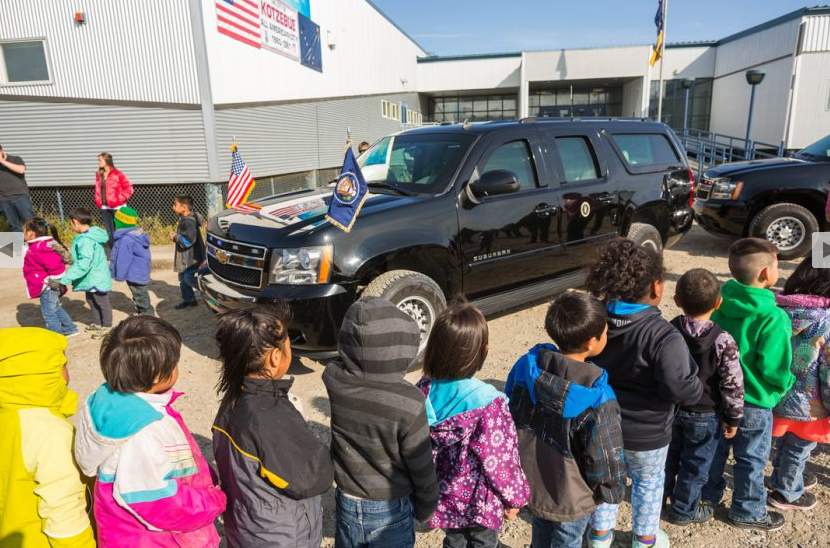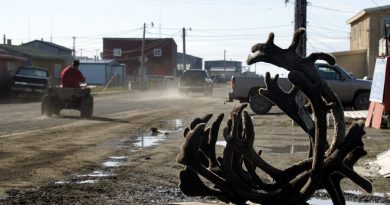Arctic Alaska town prepares for Obama visit

KOTZEBUE — You know someone big is coming to your town when people start clearing out the clutter that has long littered their yards, sacrificing potentially valuable spare parts.
For the Northwest Alaska town of Kotzebue, which is preparing for its biggest visitor ever, preparations include hauling away more than 100 rotting vehicles and destroying 10 abandoned homes that have dotted the Inupiat community for decades.
“This is like the second coming of Jesus,” joked Allen Beaver, a retired ramp agent for Alaska Airlines.
He’s referring, of course, to the long-awaited arrival of President Barack Obama, who on Wednesday will become the first sitting president to ever visit the Arctic.
Over 100 dump truck loads of junk have been hauled to the landfill in the cleanup, and that’s just the beginning of the town’s efforts to welcome the president as he caps a historic three-day trip to Alaska with what’s expected to be his final stop in the state.
Schoolchildren here have spent weeks learning “My Country, ‘Tis of Thee” in Inupiaq for a chance to sing to the president in a visit expected to last more than three hours.
Residents have been renting out four-wheelers, cars and homes to handle the crush of White House advance teams and Secret Service officials who have been in town for days — and offering them caribou soup, reindeer sausage and other goodies at several potlucks.
Tribal leaders are also flying in from villages in the region, hoping to tell the president about life in rural Alaska, the impacts of climate change and more.
Sea changes
The town, about 550 miles northwest of Anchorage, is abuzz with excitement.
Northwest Arctic Borough Mayor Reggie Joule called it “controlled giddiness,” laughing like a kid on Tuesday as the reality of the visit he’d been helping plan for weeks sank in.
“Is this really happening?” he said, pinching his arm.
Longtime residents say the visit won’t compare to those by other celebrities such as Roy Rogers and John Denver, who came so long ago many can’t remember when.
“The kids today will remember this for the rest of their lives,” Joule said. “This will be part of the stories they tell their kids and grandkids — that Kotzebue was a destination for a sitting president.”
While Kotzebue might not be as well-known as its northern neighbors Nome and Barrow, it’s a fitting stop for a president trying to promote a balanced approach by allowing offshore oil development and trying to stem climate change.
The region has experienced problems attributed to climate change firsthand — as well as the industrial opportunities presented by melting ice.
Sea lanes are increasingly free of ice and more vessels are plying the Bering Strait, meaning potential shipping jobs in the future and calls for critical Arctic infrastructure, including a deepwater port proposed for 10 miles north of the city.
And this summer, Shell is renting hotel space in town and has staged support vessels in Kotzebue Sound for its drilling operations in the Arctic Ocean, more than 300 miles to the north.
Meanwhile, the nearby village of Kivalina has struggled with a decrease in the sea ice that protected it from storms. Unusual rains in winter have coated the ground with ice, preventing caribou, a valuable subsistence food, from reaching the forage needed to survive. Spring seal hunting has gotten shorter because the ice is breaking up earlier, residents say.
A delicate balance
“The big question is about industry and subsistence — how can you have both without hurting the other?” said Lance Kramer late Monday along Kotzebue’s pebbly beach front as he filleted a dozen or so chum salmon with an ulu knife. “We have to have development, but subsistence is the most important thing.”
Kramer, the senior director of lands for the NANA Regional Corporation who also appears on National Geographic’s “Yukon River Run,” said subsistence is paramount.
He’s not happy that the Obama administration allowed Shell to drill this summer because the oil company hasn’t proven it can clean oil from ice. Still, he’s glad the president is addressing climate change.
“Alaska is the last great place to get this right. If we screw this up, everyone loses,” he said.
That ambivalence is common in Kotzebue, where regional leaders have sent Obama a letter expressing concern about climate change and highlighting the importance of subsistence but also requesting that revenue from offshore oil development be shared with local tribes and communities who bear the “greatest risk” from development.
In their short time with Obama, leaders also plan to seek federal support in a number of other areas, including for workforce training, Arctic infrastructure and renewable energy to helper lower the soaring cost of diesel fuel and gas, which runs more than $6 a gallon. They also hope to discuss the need for federal funding to help villages move, including money for a road from Kivalina that’s needed to reach a proposed school on the mainland.
Once in a lifetime
Alice Melton-Barr of Buckland said she flew in from the village to Kotzebue with her family, including two 10-year-olds, for a chance to see Obama.
“It’s so expensive to go to D.C., so when D.C. came to us, we took the opportunity to come,” she said.
While her children were impressed by a tour of the president’s helicopter in a Kotzebue hangar — one of several vehicles that travel with the president — she said she also hopes to raise awareness about the need for erosion protection in Buckland.
“We need to get erosion control because we’re losing so much ground there,” she said.
Beyond the policy discussions, Kotzebue residents are tickled that the leader of the free world is coming to their town.
Several weeks ago, amid rumors that Obama might come, Kotzebue leaders told White House staff they were getting the city prepared for his arrival whether he came or not, said Mayor Maija Lukin.
Now that he’s coming, the town is getting an unprecedented burst of attention from national outlets such as the Los Angeles Times and The Washington Post.
“This is opening the eyes of the world,” she said.
Related stores from around the North:
Asia: Asia ahead on preparing for polar climate change, says U.S. Arctic rep, Eye on the Arctic
Canada: The Arctic Council – What was accomplished and where we go from here, Eye on the Arctic
China: China’s silk road plans could challenge Northern Sea Route, Blog by Mia Bennett
Denmark: The return of the Arctic Five, Blog by Heather Exner-Pirot
Finland: US seeks Finnish support for Arctic goals, Yle News
Norway: China eyes Arctic Norway infrastructure projects, Barents Observer
Russia: The Arctic Council’s Immunity to Crimean Flu, Blog by Heather Exner-Pirot
Sweden: Arctic Council – From looking out to looking in, Blog by Mia Bennett, Cryopolitics
United States: Arctic conference spotlights indigenous issues, Alaska Dispatch News



